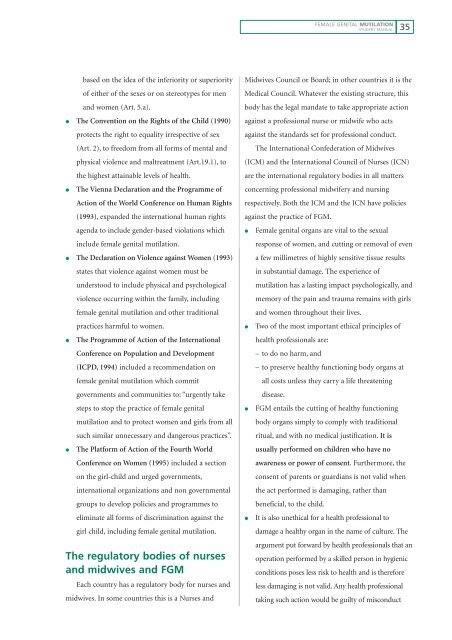Female Genital Mutilation - World Health Organization
Female Genital Mutilation - World Health Organization
Female Genital Mutilation - World Health Organization
You also want an ePaper? Increase the reach of your titles
YUMPU automatically turns print PDFs into web optimized ePapers that Google loves.
ased on the idea of the inferiority or superiority<br />
of either of the sexes or on stereotypes for men<br />
and women (Art. 5.a).<br />
● The Convention on the Rights of the Child (1990)<br />
protects the right to equality irrespective of sex<br />
(Art. 2), to freedom from all forms of mental and<br />
physical violence and maltreatment (Art.19.1), to<br />
the highest attainable levels of health.<br />
● The Vienna Declaration and the Programme of<br />
Action of the <strong>World</strong> Conference on Human Rights<br />
(1993), expanded the international human rights<br />
agenda to include gender-based violations which<br />
include female genital mutilation.<br />
● The Declaration on Violence against Women (1993)<br />
states that violence against women must be<br />
understood to include physical and psychological<br />
violence occurring within the family, including<br />
female genital mutilation and other traditional<br />
practices harmful to women.<br />
● The Programme of Action of the International<br />
Conference on Population and Development<br />
(ICPD, 1994) included a recommendation on<br />
female genital mutilation which commit<br />
governments and communities to: “urgently take<br />
steps to stop the practice of female genital<br />
mutilation and to protect women and girls from all<br />
such similar unnecessary and dangerous practices”.<br />
● The Platform of Action of the Fourth <strong>World</strong><br />
Conference on Women (1995) included a section<br />
on the girl-child and urged governments,<br />
international organizations and non governmental<br />
groups to develop policies and programmes to<br />
eliminate all forms of discrimination against the<br />
girl child, including female genital mutilation.<br />
The regulatory bodies of nurses<br />
and midwives and FGM<br />
Each country has a regulatory body for nurses and<br />
midwives. In some countries this is a Nurses and<br />
FEMALE GENITAL MUTILATION<br />
STUDENT MANUAL<br />
35<br />
Midwives Council or Board; in other countries it is the<br />
Medical Council. Whatever the existing structure, this<br />
body has the legal mandate to take appropriate action<br />
against a professional nurse or midwife who acts<br />
against the standards set for professional conduct.<br />
The International Confederation of Midwives<br />
(ICM) and the International Council of Nurses (ICN)<br />
are the international regulatory bodies in all matters<br />
concerning professional midwifery and nursing<br />
respectively. Both the ICM and the ICN have policies<br />
against the practice of FGM.<br />
● <strong>Female</strong> genital organs are vital to the sexual<br />
response of women, and cutting or removal of even<br />
a few millimetres of highly sensitive tissue results<br />
in substantial damage. The experience of<br />
mutilation has a lasting impact psychologically, and<br />
memory of the pain and trauma remains with girls<br />
and women throughout their lives.<br />
● Two of the most important ethical principles of<br />
health professionals are:<br />
– to do no harm, and<br />
– to preserve healthy functioning body organs at<br />
all costs unless they carry a life threatening<br />
disease.<br />
● FGM entails the cutting of healthy functioning<br />
body organs simply to comply with traditional<br />
ritual, and with no medical justification. It is<br />
usually performed on children who have no<br />
awareness or power of consent. Furthermore, the<br />
consent of parents or guardians is not valid when<br />
the act performed is damaging, rather than<br />
beneficial, to the child.<br />
● It is also unethical for a health professional to<br />
damage a healthy organ in the name of culture. The<br />
argument put forward by health professionals that an<br />
operation performed by a skilled person in hygienic<br />
conditions poses less risk to health and is therefore<br />
less damaging is not valid. Any health professional<br />
taking such action would be guilty of misconduct

















